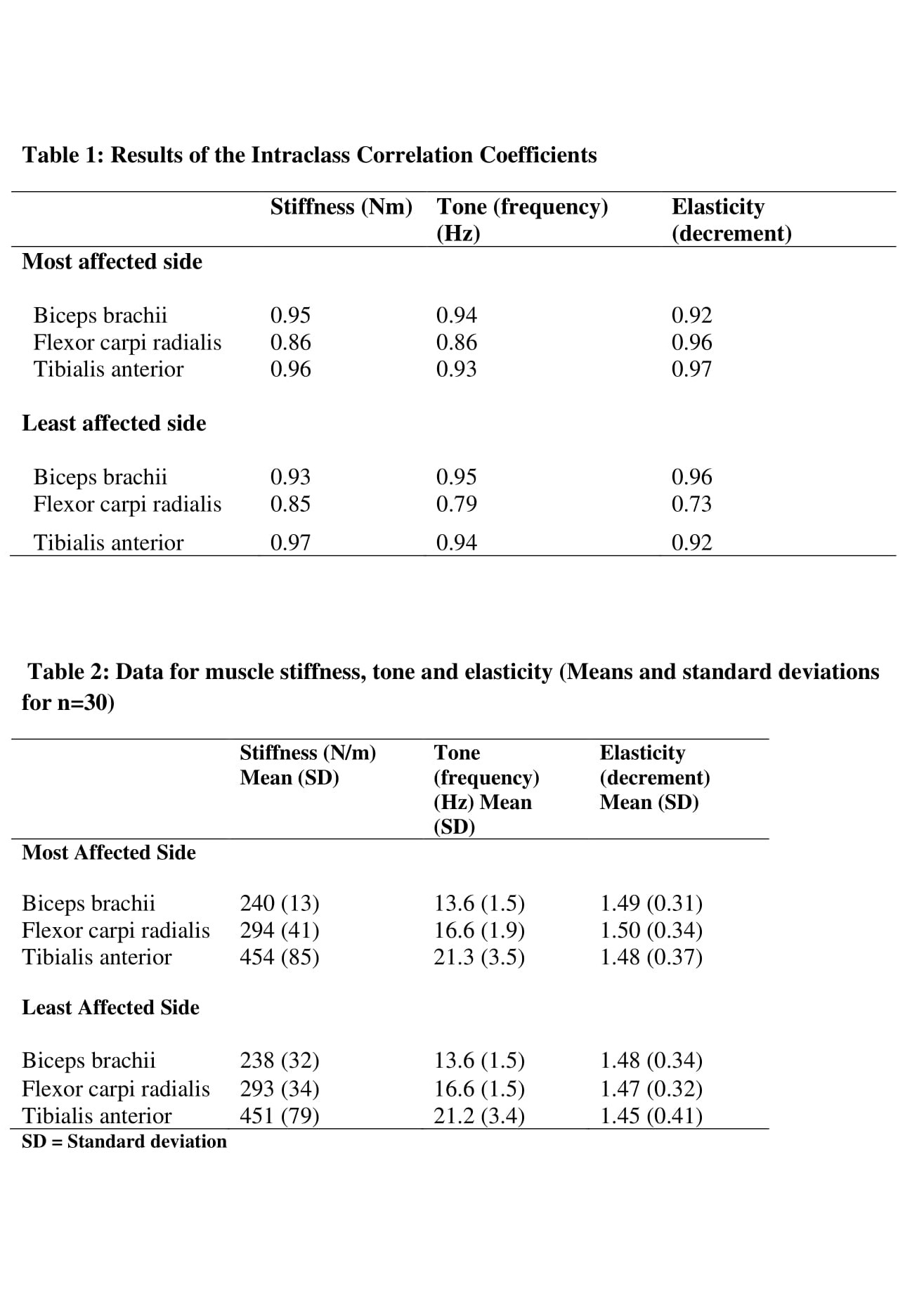Objective:
To examine the feasibility and reliability of using a myometric device to objectively measure mechanical properties of muscles in people with Parkinson’s disease in an outpatient setting.
Background: Clinically, muscle stiffness and tone are assessed subjectively by manual passive movements of a limb [1]. An objective clinical measure of muscle stiffness (rigidity) and tone in Parkinson’s disease (PD) is needed. The feasibility and reliability of a novel hand-held myometric device has been established in other populations, mainly in research environments [2,3,4] but yet to be tested in clinical environments and in the African population with PD.
Method: Thirty adults with Parkinson’s disease [66.3±8.9 (mean±SD) years, range 47-82 years], Hoehn and Yahr Stages I-III, were studied in an outpatient neurology clinic and physiotherapy department of a teaching hospital in Ghana. Biceps brachii (BB), flexor carpi radialis (FCR) and tibialis anterior (TA) were tested in relaxed supine. A hand-held myometric device that measures mechanical properties of muscle recorded three tissue parameters: stiffness (N/m), non-neural tone (frequency, Hz) and elasticity (log decrement). Group means and standard deviations (±SD) were calculated. The intra-rater reliability of two sets of data was examined within the same session using intraclass correlation coefficients (ICCs), to see whether one set would be sufficient.
Results: All 30 participants were recruited and studied within eight weeks, and the technology was acceptable to the patients and therapist. The intra-rater reliability was excellent for BB and TA muscles as all ICCs were above 0.92, and good for FCR with ICCs above 0.73 [Table 1]. The device presented real-time data for each parameter and example values for the group (n=30) on the most affected side were: BB stiffness 240±13N/m, tone 13.6±1.5 Hz and elasticity 1.49±0.31 [Table 2].
Conclusion: The technique is feasible and can easily be used in the clinical setting in patients with PD. The technology was reliable for measuring two sets of data, indicating that only one set of measurements is sufficient for clinical practice. Further studies are warranted to obtain healthy control data in Ghana and to assess the effects of physiotherapy treatments on muscle parameters.
References: [1] Xia, R., Markopoulou, K., Puumala, S.E. and Rymer, W.Z., 2006. A comparison of the effects of imposed extension and flexion movements on Parkinsonian rigidity. Clinical Neurophysiology, 117(10), pp.2302-2307. [2] Agyapong-Badu S. Warner M, Samuel D, Stokes M. Measurement of ageing effects on muscle tone and mechanical properties of rectus femoris and biceps brachii in healthy males and females using a novel hand-held myometric device. Arch Gerontol Geriatr 2016: 62: 59–67 [3] Chuang LL, Wu CY, Lin KC. Reliability, validity and responsiveness of myotonometric measurement of muscle tone, elasticity and stiffness in patients with stroke. Archives of physical medicine and rehabilitation. 93(3): 532–540, 2012. Epub 2012/01/10. doi:10.1016/j.apmr.2011.09.014 [4] Marusiak J, Kisiel-Sajewicz K, Jasko lska A, Jasko lski A. Higher muscle passive stiffness in Parkinson’s disease patients than in controls measured by myotonometry. Arch Phys Med Rehabil 2010;91:800–802.
To cite this abstract in AMA style:
M. Agoriwo, P. Muckelt, C. Osei-Yeboah, B. Sankah, S. Agyapong-Badu, A. Akpalu, M. Stokes. Objective Measurement of Muscle Mechanical Properties using a Myometric Device in People with Parkinson’s Disease in a Clinical Setting in Africa [abstract]. Mov Disord. 2020; 35 (suppl 1). https://www.mdsabstracts.org/abstract/objective-measurement-of-muscle-mechanical-properties-using-a-myometric-device-in-people-with-parkinsons-disease-in-a-clinical-setting-in-africa/. Accessed October 22, 2025.« Back to MDS Virtual Congress 2020
MDS Abstracts - https://www.mdsabstracts.org/abstract/objective-measurement-of-muscle-mechanical-properties-using-a-myometric-device-in-people-with-parkinsons-disease-in-a-clinical-setting-in-africa/

